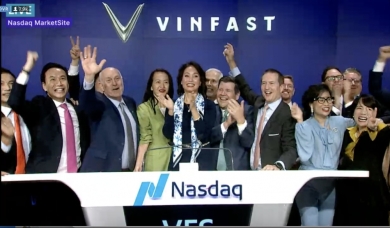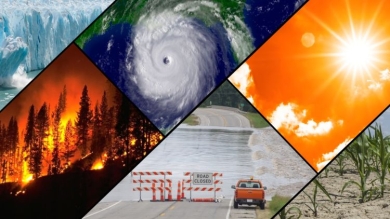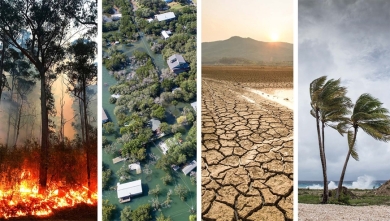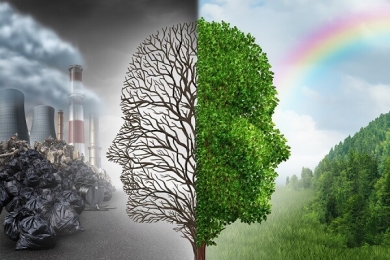For humanity’s fight against climate change to gain real momentum, we need to find the selfless courage that comes when our time is inevitably nigh.

Susie Ang for Noema Magazine
“All shall be well, and all shall be well, and all manner of thing shall be well.” — Julian of Norwich
“For whom is it well? For whom is it well? There is no one for whom it is well.” — Igbo funeral song in Chinua Achebe’s “Things Fall Apart”
In the mid-1940s, American bureaucrat John Collier surveyed the moral and ecological wreckage of the Western world and pronounced upon it bleakly. “Our race,” he wrote in the introduction to his 1947 book, “The Indians of the Americas,” “with all its lost values and values not yet lost, is wavering on the verge of self-destruction.”
Coming after two world wars and the Jewish and atomic holocausts, Collier’s was not a unique or probably even unusual appraisal. What was unusual, especially coming from a member of the U.S. civil service, were the causes to which Collier ascribed this racial self-destruction: individualism, industrialism and capitalism — “the law of the free market … considered to be the law of human life … [even] if it wrought havoc upon societies, heritages, ethical and esthetic values, family and community life, and even the natural resources of earth itself.”
Equally unusual, for its time and place, was the solution that Collier proposed. The antidote to the predations of industrial capitalism, he believed, was for non-Indigenous Westerners ultimately to come to understand that they must emulate the Navajo, Hopi and other tribal nations in cultivating “that passion and reverence for … the web of life and the earth which the American Indians have tended as a central, sacred fire since before the Stone Age.”
It is worth noting that Collier offered this not as a casual purveyor of the noble-savage trope, but as an incisive thinker, a writer of remarkable facility and a man of action in a position of power. As Franklin Delano Roosevelt’s Bureau of Indian Affairs commissioner from 1933 to 1945 and the chief author of the “Indian New Deal,” he almost single-handedly reversed the U.S. policy of Native American assimilation, put an end to the religious persecution of American Indians, and allowed many tribal nations to return to self-governance.
It was from his complex understanding of cultures in which harmonious relationships with the planet existed that Collier arrived at his core belief: If the Western world could “recapture this power” born of collectivist living within a sacralized nature, “the earth’s natural resources and web of life would not be irrevocably wasted within the twentieth century, which is the prospect now.” He termed this renewal of reverence for the Earth “the long hope,” and emphasized, “It is our only long hope.”
At roughly the same time, on the other side of the Atlantic, J. R. R. Tolkien was viewing the same slide toward ecological devastation with equal grimness. In his masterworks, “The Silmarillion” and “The Lord of the Rings,” Tolkien condemned the industrialist defilement of the planet and the growing human separation from nature. The antagonists of his created world of Middle Earth were, without exception, nature-haters and “tree-killers,” powerful men with minds “of metal and wheels” who “[do] not care for growing things, so far as they serve [them] for the moment.” He joined Collier in grieving a world where, in Collier’s words, “the core-values of the Industrial Revolution [were] made utterly regnant and its postulates as to human nature … wholly true.”
Where Tolkien differed was in what he thought we should do about it — or, more accurately, what he thought could be done. While Collier held out his “long hope” that Westerners might ultimately reject Christian-capitalist individualism and return to the kinds of animistic social beliefs held by Native Americans, Tolkien saw us as called upon to fight a valorous but never-ending and ultimately futile battle against the world-destroyers.
He termed this ongoing battle “the long defeat” and set the immortal elves of Middle Earth to fighting it through all “ages of the world,” bent on forestalling what they could not prevent: the day when the forces of power-lust would indeed be utterly regnant and the original genius of the living world snuffed out.
Some 80 years after Collier and Tolkien laid out their visions, the question of how best to respond to the devastation of the known and semi-known world has become the topic of our time. Within this discussion, hope is in high rotation and might even be seen as the main rhetorical mode of the crisis-response debate. Collier’s long hope for planetary reclamation through Indigenous-modeled spiritual reform appears in a large body of books written by, for example, environmentalist David Suzuki and scientist Leslie Sponsel.
“The traditional rhetoric of hope, long used in distorted and dishonest ways within the environmental movement, is proving unfit for our current omnicrisis.”
A shorter-term, call-to-action style of hope appears even more often, including in books by primatologist Jane Goodall, activist Rebecca Solnit and political scientist Thomas Homer-Dixon. Defeat, in the meantime, makes its customary appearance as the bogeyman, the comminatory “or else” of future days that will result if we let our hope fail; it is otherwise left out of most considered discussions.
It is safe to say that this dispensation isn’t working. Events have, as they say, overtaken us; the End Times are piling on. Yet despite the many thousands of articles, books and media segments giving voice to the self-appointed valedictorians of our time, the populations of the Western and Westernized worlds remain static, overwhelmed and obdurately hopeless.
The traditional rhetoric of hope, long used in distorted and dishonest ways within the environmental movement, is proving unfit for our current omnicrisis, and Collier’s more distant vision, appealing as it is, has no place in an era when the future turns out to have been dying back from the leading edge for decades now.
It’s clear the messaging needs to shift. David Wallace-Wells, in his climate change book, “The Uninhabitable Earth,” suggests that messaging has stayed in default trope-of-hope mode because we have no narrative to accommodate disaster on such a scale, but this is not so.
Tolkien’s story of the long defeat could be considered a bespoke oratory instrument for our era. In containing time scales from the cosmological to the organismic, it reflects at scale the deep-time cataclysms expressively upon us.
And in describing human-level battles against a series of diffuse antagonists, Tolkien’s story offers us ways to respond to them: Evoking heroism rather than hope, and courage rather than comfort, are central to this response. So too is involving people in a story instead of hectoring them with information. And, most importantly, we must take inspiration from a colder truth: We may not be able to prevent the end, but if we are willing to fight the long defeat, perhaps we can make a better one.
Failure Of The Hope Rhetoric
Which of the evidence before us suggests that the rhetoric of hope has failed? Rounding up slightly, all of it. There is, to begin with, the fact that hope rhetoric enables us to soft-pedal the impacts of climate and ecological crises, thereby helping to create an urgency gap of mock-epic proportions between what is happening and what is widely known.
Those whose job it is to see in “elfspan” — the climate scientists, the historical ecologists — report of a war that we have come to realize is upon us in medias res. It is one in which we have lost most of our ground before we even knew there was a problem, and I believe our only chance of preventing what Wallace-Wells calls the “zero earth” scenario of an uninhabitable planet is to fight a desperate rearguard action.
Any faithful rendering of their vision for the near future must perforce be quasi-apocalyptic. The outcomes of a two-degree post-industrialism rise in temperature — now considered the best-case scenario — include, as Wallace-Wells puts it, “flooded cities, crippling droughts and heat waves, a planet battered daily by hurricanes and monsoons.” And this scene omits the potentially more catastrophic effects of biodiversity loss, which the keepers of the Doomsday Clock rank as a planetary threat equal to climate change and nuclear war.
In transmitting news of this five-million-alarm fire, the hope-centric environmental authors and science writers who popularize scientific data for the masses employ the core syllogism of magical thinking — we should, therefore we must; we must, therefore we can; we can, therefore we will — to issue a raft of ought-is wafflery that would hardly prompt anyone to change out of their bathrobe.
For example, Suzuki wrote in “The Sacred Balance”: “there is hope. Each of us has the ability to act powerfully for change; together we can regain that ancient and sustaining harmony, in which human needs and the needs of all our companions on the planet are held in balance with the sacred, self-renewing processes of Earth.”
Hoper-in-chief Goodall, in “The Book of Hope,” wrote, “If everyone…starts to think about the consequences of what we do … if we all start to ask whether [an item’s] production harmed the environment … well, billions of these ethical choices will move us toward the world we need.”
Here is political scientist Homer-Dixon, in “Commanding Hope”: “we need to actively create together from our diverse perspectives a shared story of a positive future … [and] fully mobilize our extraordinary human agency to produce that future.”
“Tolkien’s story of the long defeat could be considered a bespoke oratory instrument for our era.”
The primary problem with these lines of reasoning is not their reliance on textbook question-begging: “If we do everything we need to do to save the world, we can save the world!” It’s not even that the odds of the involved parties taking timely and sufficient action can most charitably be described as not non-zero. It is the willful omission of the fact that even if they did — all of them, right now — things would continue getting worse, just (perhaps) more slowly.
Here’s the sorry truth. With the global mean temperature of our planet on track to rise by 2.5 degrees Celsius, as many scientists predict, up to six million animal and plant species are projected to go extinct, according to some estimates, due to climate change over the next 50 years.
The fact is, a large degree of failure is a fait accompli. It’s done. Therefore, any message of hope that depicts more than a fractional victory, at least within the next semi-infinite number of incarnations, is simply a falsehood. The destruction currently being wrought represents the consequences of our actions from the irretrievable past, like a bad-news letter to ourselves left long unsent. As environmental journalist Arno Kopecky writes in his book “The Environmentalist’s Dilemma”: We are “living on borrowed time. The worst is yet to come.”
The hopeists’ refusal to admit the backdated nature of our crisis, even though this lies at the heart of our challenge and causes much of our paralyzing despair, reflects a longstanding tradition within environmentalist rhetoric of turning a blind eye to both systems-level causation and the systems-level reality of discrete-seeming consequences.
Since the rise of the modern-day environmental movement in the 1970s, old-school activists have relied on a kind of Action-Hero Hope, accessorized with a judgy brand of expectations and employed in a precedent-based manner to suggest, “We stopped that clearcutting, therefore we hope [read: expect] that you can stop this clearcutting.” “Our generation got DDT banned, therefore we hope and expect that yours can get single-use plastics banned.” “We largely neutralized the nuclear threat, therefore you should not give up hope that you can reverse the thinning of the ozone layer.”
This pair-and-compare tradition, which omits the inconvenient reality that consumerist capitalism has generated crises of ever-greater scale at an ever-greater pace, has always been essentially dishonest. Still, activists may have considered it the best form of messaging for Western audiences with a nodalized view of history and an aversion to systemic change.
Now that systemic consequences have fully decloaked, though, this pretense has become farcical. More to the point, it has become rhetorically disqualifying. For one, when exhortations to keep our chin up by remembering past victories come with expectations that we will devote our thusly bucked-up selves to saving the world, resentment is bound to arise. And it is indeed arising, in force, especially among youths who have essentially been nominated to do most of the work. This only adds to the inaction that hope is meant to overcome.
Isabel Drury, writing for the newsletter Gen Dread, noted that when people from older generations say, “Younger people’s dedication to the climate crisis gives me hope,” what she hears is “Yeah, I know we fucked up the planet pretty bad … but I can’t do anything about it now. It’s your problem. Good luck!”
Adding to the offensiveness of coerced hope is the false equivalency between, say, saving one piece of a rainforest from logging and saving the entire world from climate collapse on multiple fronts. These writers may as well say, “Years ago, I rescued a fly from a windowsill. Now, using the same technique, you can keep the Hindenburg from crashing.”
The unprecedented quality of our current crisis — different in both degree and kind — is evident on its face and much commented upon, yet the hope-writers continue to base their arguments on inapplicable references. More than a few, for instance, mention political scientist Erica Chenoweth’s treatise claiming that all you need is 3.5% of the population engaged in a civil resistance movement for it to succeed. In “The Environmentalist’s Dilemma,” Kopecky remarks in response: “So far as I know, none of Chenoweth’s case studies succeeded in overthrowing human voraciousness.”
Why do these established environmental writers hold onto hope rhetoric and resist modifying it even as it becomes clear that the whole-integer hoped-for outcomes that they promise fly in the face not only of future probability but also of current-day reality?
“We may not be able to prevent the end, but if we are willing to fight the long defeat, perhaps we can make a better one.”
We can only assume that this is a mass instance of streetlight argumentation: Like the person who looks for their keys under the streetlight not because it’s where they dropped them but because it’s where it’s easiest to look, the orators of our day may simply be using the rhetoric of hope because it’s the only kind they know.
To deflect from the fact that hope is, in Emily Dickinson’s words, “the thing with feathers” and arguably should not be in the galvanizing business at all, the writers use yet another rhetorical fallacy, namely, persuasive definition: beefed-up descriptions of hope’s qualities and powers.
Goodall, for instance, wrote, “People tend to think that [hope] is simply passive wishful thinking: I hope something will happen but I’m not going to do anything about it. This is indeed the opposite of real hope, which requires action and engagement.”
In a 2023 interview with climate journalist Stella Levantesi, writer and activist Rebecca Solnit agrees that hope is more than passive wishful thinking: “Hope for me,” she declares, “is just recognizing that the future is being decided to some extent in the present, and what we do matters because of that reality.”
Those with dictionaries synchronized to a more conventional standard will find the verb “to hope” defined as “to desire with expectation of fulfillment; to wish; want.” In short, it means wishful thinking.
Added to the gerrymandered definitions are inflated tales of hope’s past achievements. For instance, in “The Book of Hope,” Goodall’s co-author, Douglas Abrams, relates what is meant to be an inspirational anecdote used by Holocaust survivor and psychologist Edith Eger. Eger talks of a young prisoner in Auschwitz who keeps herself alive on hope based on the rumor that they will be freed by Christmas. When Christmas arrives and liberation hasn’t come, the girl immediately dies. As a depiction of the triumph of hope over reality, this story is a powerful example of exactly the opposite, but by tendentiously drawing his conclusion from the middle of the story instead of the end, Abrams makes it serve his rhetorical purpose.
A more honest portrayal of hope’s role in such situations comes from former Vietnam War Navy Vice Adm. Jim Stockdale, who was a prisoner of war. Asked to characterize who failed to make it out of the Vietcong camps alive, he replied: “Oh, that’s easy. It was the optimists. They were the ones who said we were going to be out by Christmas. And then they said we’d be out by Easter and then out by Fourth of July and out by Thanksgiving, and then it was Christmas again … I think they all died of broken hearts.”
More realistic yet is the speculation of naturalist Ben Gadd, who, in a 2007 university lecture, leaves hope out of the matter altogether and attributes survival to “the ability to look the other way.” He notes that this ability helped “everyone at Auschwitz, prisoners and gas-chamber attendants alike” get through the days, leaving “surprisingly large numbers of both parties still alive” at the end of the war.
The “Long Hope”: An Unaffordable Luxury
If the messaging of garden variety hope has an array of problems, Collier’s long hope — namely, that Western and Westernized populations will solve the problem of ecological destruction by reforming their worldview along an Indigenous model — introduces a different set of problems. To begin with, a near-infinite amount of time is needed to fulfill this vision, while the current planetary emergencies call for immediate action — not to say time travel to an earlier point in ecological history. This isn’t stopping a growing number of writers from extolling long-hope solutions.
For instance, Sponsel wrote in his book “Spiritual Ecology”: “The time is long overdue for the world to listen to the wisdom of Indigenous people and to do many things quite differently from the pathology of the dehumanizing and desacralizing obsessions of Western capitalist materialism, consumerism and greed that even endangers the home planet as a whole.”
Likewise, community organizer Dennis Martinez extolled “the relevance of traditional Indigenous peoples as an alternative modernity.” Biologist and philosopher Fulvio Mazzocchi, in a 2020 paper published in The Anthropocene Review, wrote about the need for gleaning the “insights that indigenous knowledge may provide, [and] analyzing the principles which oversee indigenous relationship with nature, like reciprocity and caretaking…[which] move from a profound sense of unity and interconnectedness and put emphasis on the importance of giving back to nature.” And perennial hope-promoter Suzuki wrote: “We need a new kind of science that approaches the traditional knowledge of indigenous communities; the search for it has already begun.”
“Hope rhetoric enables us to soft-pedal the impacts of climate and ecological crises, thereby helping to create an urgency gap of mock-epic proportions between what is happening and what is widely known.”
One is tempted to say, along with the movie version of Tolkien’s Saruman, “What time do you think we have?”
As with the imaginings of shorter-hope outcomes, the temporal self-indulgence of these long-hope visions betrays an underlying lack of integrity about the nature, scale and root causes of our crises. Let’s set aside that becoming spiritually enlightened on a deadline is tricky and doing it for transactional reasons contains its own contradictions.
The gravamen of the issue is that the necessary condition for forming collectivist societies centered around animistic beliefs, namely, the overthrow or elsewise-engendered absence of the Christian-industrial-capitalist complex, is no closer to existing now than it was in Collier’s day. In fact, it is much further away. Even Collier saw animism as replacing, not existing within, this complex — though it is true that, with rather touching naivete, he imagined that we might be propelled to make this shift sheerly out of spiritual starvation.
Presumably, if it were possible for collectivist animism to co-exist with the Western worldview and economic system, it would already be doing so. Or rather, it wouldn’t have stopped doing so in the first place and most of the peoples of the world who are neither Indigenous nor Judeo-Christian would continue expressing their reverence of nature within the religions they already have, rather than feeling the need to adopt Indigenous ones. After all, nearly half of the world’s 8 billion people espouse a religion with more or less animistic belief systems that, as comparative religion scholar Karen Armstrong points out in her book, “Sacred Nature,” contain belief systems that sacralize nature at their core: Islam, Hinduism, Buddhism, Daoism, Confucianism.
Yet the Earth-sacralizing elements of these powerful belief systems have not been able to withstand the twin forces of Judeo-Christianity and techno-industrial capitalism. As historian Lynn White, Jr. noted in his 1967 essay, “The Historical Roots of Our Ecological Crisis,” the first of these separates us from and putatively raises us above the rest of the living (and non-living) world, while the second exploits this spiritual detachment for individual gain. Forcibly imposed by and steadily exported from the West, these machine-like forces have overwhelmed all others and hollowed out the nature-worshipping elements that might resist it. Nor is it yet done doing so: A 2023 study showed that industrial development threatens more than 60% of the Earth’s Indigenous-held lands, an area almost seven times the size of India.
Until we find a system where, as the 19th-century English judge Lord Bowen might put it, the unjust stop stealing the just’s umbrella, the chances of the long hope being realized remain deep in the negative integers.
There is, in fact, an element of cruelty to the long hope’s promise of saving the world through a mass resacralization of nature. A return to a closer relationship with nature is arguably the hope most deeply held in the human heart and the atavistic human brain. Biophilia, the human tendency to connect with the natural world, is a powerful force that arguably comes second only to our need to be social.
The long hope speaks to the sundering of human nature and the human spirit; it whispers to us that we might yet reunite the two. This hope is the reason for Westerners’ envy of Indigenous peoples — as ironically unjust as that emotion may be in historical terms — and for grief over environmental destruction, an emotion that is also growing more prevalent.
But fulfilling this hope has become more unachievable even as it has become more needed. Economically enforced urbanization has been accelerating in all parts of the world since the start of the Industrial Revolution and continues to do so. By 2050, nearly 70% of the human population will live in cities, many of them because they have no choice.
For environmentalists to say that we can save ourselves and the planet by being more in touch with our animal selves seems little more than a taunt by an entitled caste who can forest-bathe on their glamping trips, deer-watch while at their country cottage or spend months in the wild monitoring their latest biology project.
For most of us, even in rich countries, renewing our internal sacred flame would do little more than add a burn wound to the point of amputation. In practical terms, it’s hard to see how this reformation would work even as applied to the apartment building next door, never mind to all 4.4 billion people living in cities today.
“The long hope speaks to the sundering of human nature and the human spirit; it whispers to us that we might yet reunite the two.”
There is a hypocrisy, too, in touting the hope that we will take a less hubristic view of humanity, achieve a greater sense of reverence for the planet, and through this, be spurred to change our unsustainable ways. Even while this vision preaches species humility, the expectations it carries could only be met through godhood outright and the denial of our species’ limitations.
As writers from Wallace-Wells and Bill McKibben to Timothy Morton and Rob Dunn point out, seemingly hardwired species traits, or what Dunn calls “a set of lawlike biases,” can hamper our ability to respond effectively to overwhelming prospects such as mass extinction, ecological destruction and climate change. Perhaps the best-known of these tendencies is bystander apathy in conditions of diffused responsibility, which is at the very core of our multiple global crises.
Kopecky underlines this when he writes, “I can swear off the internal combustion engine, renounce meat, cover my roof in solar panels, touch no plastic, and plant a hundred trees a day for the rest of my life, and none of it will bring the atmospheric concentration of carbon dioxide any closer to 350 parts per million, nor ease the world’s biodiversity crisis. Those things will only happen when hundreds of millions of people change their consumption habits.”
And bystander apathy is only one item on a nearly endless list of psychological barriers to action, many of them individually insuperable. Wallace-Wells starts in the As of this list of cognitive biases that make action difficult — anchoring, the ambiguity effect, anthropocentric thinking, automation bias — and moves on to the Bs without even touching on the availability heuristic, which leads us to skew our thinking toward the most easily seen and understood events at the expense of ineffable impacts, like ecological and climatic disturbance.
Then there’s normalcy bias, which inhibits us from believing in, and therefore makes us underestimate or fail to plan for, disasters that we’ve never experienced before. Shifting-baseline syndrome means that “the world as we know it” can become increasingly devastated without us perceiving it to be so.
The phenomenon of “inattentional blindness” keeps us from noticing even the most flagrantly dramatic events when we are focused on something else (for instance, whether we can afford to put food on the table). In typical experiments on selective attention, subjects consistently fail to notice a person in a gorilla suit casually dancing their way past a group of basketball players.
Change blindness is when a person fails to notice a change in their environment after an interruption, like reading a text message while driving. This is compounded by “change blindness blindness”: our refusal to believe that we could possibly have failed to notice something so dramatic.
The list goes on and on and on. Distance bias, similarity bias and “compassion fade” incline us to disregard the plight of others. Quality-of-life, or lifestyle creep, prompts most people who can afford it to consume more, not less, and makes us highly resistant to giving up what the Brits call “mod cons”; as McKibben puts it in his book “The End of Nature,” “A voluntary simplification of lifestyles is not beyond our abilities, but it is probably beyond our desires.”
These are just a few of the perceptual distortions that our human-species brains tend to create in the face of threats outside the ones we evolved to cope with. They disarm us for many of the actions that hopers exhort us to take. Do the hope-promoting environmentalist writers really believe that we, as humans, are members of the animal kingdom and part of the living world? Or are they, in fact, according us some special status as a species, the same anthropocentric belief that got us into this trouble to start with in the first place?
Nor is the hope for effective government policies much more realistic. Governments, too, are bound by laws, and in this discussion of ham and eggs, they are the pigs, committed to the project until their deaths, and the rest of us merely chickens. As Homer-Dixon notes, governments are caught between the horns of the “enough vs. feasible” dilemma: actions they might take that would be sufficient to avert catastrophe are unfeasible, and actions that are feasible for them to take are insufficient.
And since democratic governments, by definition, operate on short-term election cycles, any government with the courage to enact long-term pro-environment policies is likely to accomplish little beyond hastening its own political demise. In many instances, an environmentally courageous government simply results in the subsequent election of anti-environment autocrats.
Despite this multitude of problems both logical and logistical, the rhetoric of hope remains not only in play but a dominant oratory pattern that’s sheltered by the assumption, as unchallenged as it is unexamined, that, as Goodall states: “Without hope, all is lost.”
But is it? Or does this claim effectively retcon human history, which is full of battles fought sans hope? Many even among the living will speak of reasons for going into the trenches with no thought of hope — unable, in fact, to afford such an emotion. Most go because they must. Others talk of honor and duty, of love of family and country, of allegiance to a higher cause, an urge to test their mettle, or simply a desire for the world as they know it to continue. The argument that we need hope to go on does an injustice to the sacrifices of those who have gone on regardless of it, and it gives short shrift to all we can be.
“’Without hope, all is lost.’ But is it? Or does this claim effectively retcon human history, which is full of battles fought sans hope?”
What little science exists on the subject suggests that it’s tricky to study causal relationships between hope and action in climate change. For instance, psychologist Maria Ojala’s 2023 research review of the role of hope in the climate-change era found that differing definitions of hope led to contradictory or inconclusive results. A few studies she looked at showed that constructive hope had a positive relationship with engagement, but hope based on climate denial was negatively related to engagement with climate change.
In the field, there seems to be every sign that this is the case. By conflicting with increasingly publicized and incontrovertible evidence, the claim that there is still hope and still time appears to push some people further into denial and others into a higher level of cognitive dissonance — both psychological states that come with immense emotional and energetic costs and add to our general state of paralysis.
The Greater Wisdom Of “The Long Defeat”
In fairness, no one has succeeded in motivating the inert masses, including the so-called “alarmists” and “doomers.” As Kopecky notes, neither scaring people nor not scaring them is working — if by “working,” we mean to say giving them a way to cope psychologically with the overwhelming nighness of it all and helping them break out of the resulting paralysis.
For any mode of argument, it’s a heavy lift. Wallace-Wells observed that for a climate-change catastrophe that is already costing roughly the equivalent of “an annual Holocaust” in human lives and that stands, in the two-degree-rise scenario, to potentially kill 25 Holocausts’ worth of people by the end of the century, from air pollution alone, “There is simply no analogy to draw on, outside of mythology and theology.”
So why not go to mythology? Are we saving the heroic storylines for something else? Tolkien’s long defeat is at hand, forged over 60 years and a miracle of aptness for our times. Whether the rhetoricians’ reluctance to take up this tool stems from the intellectual hypoxia of the academic left or some sort of interdisciplinary crown shyness, we can’t afford to overlook Tolkien’s gift for much longer.
For all the reasons that hope rhetoric fails to meet the occasion, the long defeat succeeds. It is uniquely applicable to our current battle, with its multiple timelines, because Tolkien’s elves are immortal and thus can view history on both ecological and evolutionary time scales. This allows them to understand even the great victory in the War of the Ring as merely a temporary stay in the long defeat.
Among other merits, this truly long view has the potential to provide immediate psychological relief. Conceiving of history as serial rather than episodic re-amortizes time — stretching out the past to take the weight off our present — and makes it incremental enough that the future seems almost manageable.
In this conception, it should be said, Tolkien was merely accurate, not prescient. Those keeping an eye on the overall trajectory of the planet, so long as they were not egoistically invested in presenting individual environmental successes as meaningful systemic victories, would have arrived at the long defeat as a simple description of reality.
In fact, quite a few people already have: Tolkien has plenty of company in depicting history as a downward curve. Christians date our slide from the Fall of Man, many historians from the rise of Christianity. Author Ronald Wright speaks of the “progress traps” in which technological innovation permits a civilization to grow to the point of needing more innovation, in an upward-spiraling game of catch-up that continues until civilization collapses.
“Why not go to mythology? Are we saving the heroic storylines for something else?”
Groundbreaking biologist E.O. Wilson goes even further back, to what he calls evolutionary autocatalysis: a self-caused acceleration of changes, each change adding to existing ones to increase the rate at which new changes are created, in a kind of evolution-compounding effect.
For humans, autocatalysis played a definitional role in our species’ identity and our alienated status. We began living on the ground and walking upright, which freed up our hands so that we could create and use tools. This, together with our sociability, prompted us to hunt collectively, enabling us to successfully hunt prey larger than ourselves. Soon, we were the dominant predator of the plains and in our uneasy position of suspension over the rest of the world, largely let off the leash but still dependent on nature’s larder. Continued autocatalysis solidified our alienation from the rest of nature; subsequent developments such as civilization, the advent of agriculture, industrial capitalism and Judeo-Christianity, added multiple reinforcements.
These variations on humanity’s fallen status tell much the same story as Tolkien’s long defeat, with one crucial difference: They aren’t stories. Or rather, Judeo-Christianity is, and one of the greatest — but it belongs to the other side, the species-exceptionalist version of humanity that has underwritten the desecration of the natural world.
Yet story — one of our original and most critical survival tools — is what we need now. The human brain evolved to be captured by and retain stories specifically to let knowledge (“lions over that hill”) shape action (“let’s take a different route”). Our primeval species’ response to story may alone be capable of short-circuiting the relatively newer evolutionary traits that hold us in paralysis.
It was largely the narrative and vividly imagined imagery in Wallace-Wells’s “The Uninhabitable Earth” that shocked the public into awareness of the disaster looming. To combat story with data and lecturing, or even epic with anecdote, can only leave the world’s populations frozen and leaderless and lead us all to a very short defeat.
Envisaging ourselves within the story of the long defeat restores poetry and power to our story. It shows us that any acts of personal sacrifice and heroism are part of our journey. Used well, this rhetoric of the long defeat could encourage people to engage in battles to save species and habitats and do what they can to slow climate change.
It can also remind us that we have many ways of responding to the prospect of defeat and to the reality of it, even in the absence of hope. Between the poles of the species arrogation that has caused our catastrophe and the species shame now arising in response to it, lies our genuine species greatness, with things to be found there that are neither hope nor despair: courage, valor, humor and love; a capacity for self-sacrifice and hardihood; camaraderie and a deepening of self; transformation and, in some cases, faith. Instead of waiting on hope to trigger a miraculous sea change, we can use the story of the long defeat to move on the tide of our strengths.
There is, too, consolation in the thought that we are part of a continuum of defeat — in good company, rather than isolated in history and facing a chunk of time that contains an impossible task and demands an unachievable victory. The long defeat shows that it has always been thus, that living with the outcomes of the past is nothing new and our predicament not unique.
We are not alone in our inadequacy, nor the first to lose before we begin, though we may well be the last. As one leader in the War of the Ring says to a disheartened and frightened companion, all who live to see such times wish they hadn’t, but “that is not for them to decide. All we have to decide is what to do with the time that is given us.”
And in this story, defeat comes with important qualifiers. First, it is the long defeat, which reminds us that although the case may be terminal, it is not yet palliative. There is hope — just a different hope, for small victories and courageous battles. Secondly, we are summoned to “fight the long defeat,” not lie down and let it roll over us.
We need that call to heroism, which is sorely missing from the rhetoric of hope. Who wants to fight the dark forces, even in minor ways, without the possibility of recognition and perhaps even glory? Who wants to make sacrifices knowing that these are taken for granted?
“Instead of waiting on hope to trigger a miraculous sea change, we can use the story of the long defeat to move on the tide of our strengths.”
Tolkien’s King Théoden, vastly outnumbered and facing almost certain annihilation at the Battle of Helm’s Deep, models the mindset of the long defeat when he says, “The end will not be long. But I will not end here, taken like an old badger in a trap. I shall ride forth … Maybe we shall cleave a road, or make such an end as will be worth a song — if any be left to sing of us hereafter.”
A Call To The Storytellers
It is odd, on reflection, to see so many writers and thinkers argue that accepting the end will inculcate fatalistic inaction when this is rarely our human experience. When a loved one learns that their diagnosis is terminal, we don’t walk away or sit around in a paralysis of inaction and escapism.
In fact, counselors, clergy and medical professionals tend to observe that facing the end calls up the best of humanity. People confronting their death often “find their courage,” as Tolkien writes of one battle-shy character. They make meaning of their end and access strength they didn’t know they had. The people who love them can catch their first glimpses of grace.
The human capacity for connection, love and compassion — part of our species advantage that has allowed us to dominate the planet — can be harnessed for positive ends by a mutual acknowledgment that we are fighting our last battles. This allows the grief and fear that many feel to be salved by the compensations of wisdom and maturity.
Paradoxically, accepting that we face certain defeat would also be the first step toward the spiritual and ontological reformation needed to fulfill Collier’s long hope. It speaks of species humility, a key element of Indigenous perceptions of the world. Where hopers such as Goodall continue to rely on the supposedly “indomitable human spirit,” accepting that we might lose this fight and even be extinguished acknowledges that we are, in fact, eminently domitable. We may never fully reintegrate with the rest of nature (unless we are forced to), but accepting the limitations of our species-hood begins to lower the Great Chain of Being, until we may come within touching distance of the web of life.
It has not gone unnoticed that the messaging of the climate and biodiversity crises is so far failing utterly. Those who collect and pass on the data seem bewildered by the fact. In May, when The Guardian asked 380 top climate scientists how they felt about the future, the responses were of depression layered with confusion.
“I find it infuriating, distressing, overwhelming,” said one. Replied another, “The world’s response to date is reprehensible — we live in an age of fools.” A third described the most recent IPPC report’s writers as being “at the end of their rope.”
We should not be surprised that the story of the state of the world and our role in it is being so ineptly told. The activists and academics who have served as the scientists’ main scribes insist on clinging to a message of hope that is increasingly a message of dishonesty and cowardice. Unable to understand the difference between what inspires people and what disheartens them, they are unsuited to tell the story of even the best of times; it is certainly far beyond them to forge a rhetoric for these urgent ones.
If they continue to refuse to grasp the nettle of truth, we will need to turn, and soon, to storytellers who can. We need to be listening to those with the courage to treat in reality, those who understand that our task now is to delay the end by fighting these last battles of the long defeat against the earth-and-sky destroyers. In that delay, we may make such an end as may redeem, even if it cannot save, the human species.
Corrections: On Oct. 18, 2024, this essay was edited to make clear that the estimated loss of 25 Holocausts’ worth of people is a potential possibility that could occur by the end of the century, rather than annually, and solely due to air pollution. Additionally, the essay was edited to make clear that the possible loss of up to 6 million plant and animal species is a finding from a study that looked at a scenario where there was a 2.5-degree Celsius increase in the global annual mean temperature over roughly 50 years, not the immediate halting of CO2 emissions.
By Pamela Swanigan - NoemaMag









